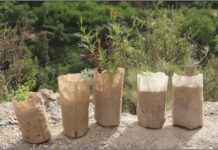Climate change is having a serious impact in the water-scarce in South Africa’s Western Cape leading to decreased rainfall, rising temperatures, and extreme weather conditions.
Water scarcity in the province is, therefore, seriously threatening agricultural production and rural livelihoods.
However, according to Water Science Policy, in a recent assessment carried out in the Western Cape, it was highlighted that recycling treated wastewater for irrigation purposes offered benefits for climate adaptation and the agricultural sector.
“Reusing 50% of the wastewater by 2060 would cover the water demand of 330 additional hectares of agricultural land, which would reduce water insecurity, increase agricultural productivity, and create additional jobs,” a Water Science Policy report, released recently, shows.
It added the cumulative benefits from water recycling amounted to more than US$29 million over the next 40 years.
“Harvesting treated water before it reaches the estuary also benefits the sensitive ecosystem by diverting part of the nutrient-rich effluent. Our assessment shows that water harvesting reduces the nutrient loadings reaching the estuary by almost 50%.
“The integrated cost-benefit analysis indicates that the additional water recycling is a key factor in making all three water treatment investments economically viable.”
The Water Science Policy assessment also noted that one of the added benefits of the constructed wetland is that it serves as a habitat for birds and other animals, as well as a source of tourism revenue.
“Our financial model shows that integrating water harvesting into the calculations of the sustainable internal rate of return and the sustainable net present value of each option considerably improves their profitability.”
In its recommendations, Water Science Policy said assessment results had provided a strong incentive to swiftly expand the capacities to reuse water as this is key for protecting the estuary.
“Policy-makers should prepare to amend water use licenses in parallel to upgrading the wastewater treatment infrastructure. This policy change would ensure that water harvesting can begin as soon as the improved treatment infrastructure is in place.”
Commenting on the Water Science Policy report, Catherine Bill, a senior official with the Western Cape government said wastewater treatment in the province would help farmers adapt to climate change, and protect the Hartenbos estuary.
An estuary is a partially enclosed coastal body of brackish water with one or more rivers of streams flowing into it with a free connection to a sea.
“This customised valuation of different sewage treatment options helps policy-makers in South Africa make informed decisions about infrastructure investments,” she said.
Bill added: “It highlights the cost-effective wastewater treatment by hybrid infrastructure and the large societal benefits of NBI (nature-based infrastructure). We see how investing in nature can support the tourism sector, help farmers adapt to a changing climate, and protect the sensitive Hartenbos estuary.
“Realising this potential will require stakeholders to recognise the greater benefits to be achieved by working together instead of focusing only on their own mandates.”
In its report, Water Science Policy also noted that high nutrient concentrations from sewage treatment are threatening the Hartenbos estuary, a highly sensitive ecosystem in Mossel Bay.
“The results show that hybrid infrastructure, a combination of grey and NBI, offers cost-effective wastewater services and outperforms the treatment efficiency of conventional alternatives.
“It also provides additional co-benefits such as additional water supply and tourism opportunities for the Mossel Bay municipality.
“This assessment shows that hybrid alternatives are not just cost-competitive when it comes to the cost of treatment but also outperform grey alternatives in terms of treatment efficiency.”
The high nutrient concentrations in the estuary regularly lead to algae growth and the death of fish due to a lack of oxygen.









